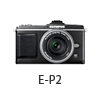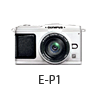 |
 |
|
|

Questions :
See the following Web page for general questions and answers for OLYMPUS OM-D and OLYMPUS PEN series cameras :
Question
What differentiates the E-P2 from the E-P1?
Answer:
The following table describes the differences:
|
|
 |
 |
| Effective Pixels |
12.3 million pixels |
| Lens mount |
Micro Four Thirds Mount |
| Body color |
Black, Silver |
White, Silver |
| Memory |
SD Memory Card, SDHC Memory Card |
| Built-in flash |
Not available |
| Hot shoe |
Available |
| External electronic viewfinder |
VF-2 ( sold separately ) |
Not available |
| LCD display |
3.0 inches HyperCrystal LCD |
| Movie shooting |
Available |
| In-body image stabilization |
Approx. 4 EV steps ( in maximum effect ) |
| Sequential shooting |
Approx. 3 frames per sec. |
| Focus mode |
Single AF (S-AF),
Continuous AF (C-AF),
Manual Focus (MF),
S-AF + MF,
AF tracking (C-AF + TR) |
Single AF (S-AF),
Continuous AF (C-AF),
Manual Focus (MF),
S-AF + MF |
| Enlarge select AF |
Available |
Not available |
| Menu languages |
34 languages including Japanese and English |
Japanese and English
(Additional one language is possible to download using OLYMPUS Master 2. An internet connection is required) |
| Picture mode |
i-ENHANCE, VIVID, NATURAL, MUTED, PORTRAIT, MONOTONE, CUSTOM |
VIVID, NATURAL, MUTED, PORTRAIT, MONOTONE, CUSTOM |
| Art filter |
8 art filters:
POP ART, SOFT FOCUS, PALE&LIGHT COLOR, LIGHT TONE, GRAINY FILM, PIN HOLE, DIORAMA, CROSS PROCESS |
6 art filters:
POP ART, SOFT FOCUS, PALE&LIGHT COLOR, LIGHT TONE, GRAINY FILM, PIN HOLE |
| Multi exposure |
2 frames max. |
Underwater Housing
(sold separately) |
Not available |
| Accessory port |
Available
( Accommodates the VF-2 Electronic viewfinder or EMA-1 Microphone adapter ) |
Not available |
| HDMI output connector |
Available |
| Dimension |
120.5 mm (W) x 70.0 mm (H) x 35.0 mm (D) /
4.7" (W) x 2.8" (H) x 1.4" (D)
( excluding protrusions ) |
| Weight |
335 g ( body only ) |
| Release date |
December, 2009 |
July, 2009 |
|
Question
How long is the shutter-release lag-time?
Answer:
|
After the shutter button is pressed halfway, it takes about 0.07 second to release the shutter.
|
Question
Which types of memory cards can I use?
Answer:
|
SD and SDHC cards can be used in the E-P2.
xD-Picture Card™ and CompactFlash® media cannot be used.
|
Question
What are the compression rates and what size are the image files in each record mode?
Answer:
|
【 Still pictures 】
The following table shows the approximate values when shooting still pictures in the 4:3 aspect ratio. File size and the number of storable pictures vary depending on the image quality selected.
| Record mode |
Compression rate |
Number of pixels |
File format |
Number of storable pictures in a 1GB SD/SDHC card |
File size (approx.) |
| RAW |
Lossless compression |
4032x3024 |
ORF |
54 |
14MB |
| Large |
SF
(Super Fine) |
1/2.7 |
JPEG |
101 |
8.4MB |
F
(Fine) |
1/4 |
145 |
5.9MB |
N
(Normal) |
1/8 |
320 |
2.7MB |
B
(Basic) |
1/12 |
477 |
1.8MB |
| Middle |
SF
(Super Fine) |
1/2.7 |
3200x2400 |
JPEG |
154 |
5.8MB |
F
(Fine) |
1/4 |
255 |
3.4MB |
N
(Normal) |
1/8 |
504 |
1.7MB |
B
(Basic) |
1/12 |
747 |
1.2MB |
SF
(Super Fine) |
1/2.7 |
2560x1920 |
JPEG |
269 |
3.2MB |
F
(Fine) |
1/4 |
395 |
2.2MB |
N
(Normal) |
1/8 |
776 |
1.1MB |
B
(Basic) |
1/12 |
1143 |
0.8MB |
SF
(Super Fine) |
1/2.7 |
1600x1200 |
JPEG |
673 |
1.3MB |
F
(Fine) |
1/4 |
993 |
0.9MB |
N
(Normal) |
1/8 |
1893 |
0.5MB |
B
(Basic) |
1/12 |
2753 |
0.4MB |
| Record mode |
Compression rate |
Number of pixels |
File format |
Number of storable pictures in a 1GB SD/SDHC card |
File size (approx.) |
| Small |
SF
(Super Fine) |
1/2.7 |
1280x960 |
JPEG |
1044 |
0.9MB |
F
(Fine) |
1/4 |
1514 |
0.6MB |
N
(Normal) |
1/8 |
2884 |
0.3MB |
B
(Basic) |
1/12 |
4038 |
0.3MB |
SF
(Super Fine) |
1/2.7 |
1024x768 |
JPEG |
1594 |
0.6MB |
F
(Fine) |
1/4 |
2243 |
0.4MB |
N
(Normal) |
1/8 |
4038 |
0.3MB |
B
(Basic) |
1/12 |
5507 |
0.2MB |
SF
(Super Fine) |
1/2.7 |
640x480 |
JPEG |
3563 |
0.3MB |
F
(Fine) |
1/4 |
5048 |
0.2MB |
N
(Normal) |
1/8 |
8654 |
0.2MB |
B
(Basic) |
1/12 |
10096 |
0.1MB |
Note:
| - |
The number of storable pictures depends on the image quality and the type of memory card. |
| - |
The number of remaining storable pictures displayed on the LCD shows the maximum (up to 9999). |
|
【 Movies 】
| Record mode |
Image size |
Frame rate (frames per second) |
Recording time in a 2 GB SD/SDHC card (with sound) |
| HD |
1280×720(16:9) |
30 fps |
approx. 7 min. |
| SD |
640×480(4:3) |
30 fps |
approx. 14 min. |
Note:
| - |
The maximum file size of a movie is 2 GB. This is a limitation of the AVI file format. |
| - |
When shooting with an Art Filter, the frame rate varies based on the selected filter. |
| - |
In movie mode, IMAGE STABILIZER uses electronic stabilization. With this function, the recorded image is slightly enlarged. The IMAGE STABILIZER cannot correct excessive camera shake. |
| - |
A Speed Class 6 SD or SDHC card is recommended for movie recording.
|
|
|
Question
What are the differences between the image stabilizer modes? Can I turn off the image stabilizer?
Answer:
|
You can select from three image stabilizer modes: I.S.1, I.S.2 and I.S.3.
In the default setting, the image stabilizer is set to OFF.
| Mode |
|
| OFF |
Image stabilizer is OFF. |
| I.S.1 |
Image stabilizer is ON. |
| I.S.2 |
This allows you to track the subject by panning the camera horizontally.
The image stabilizer corrects only the vertical camera shake. |
| I.S.3 |
This allows you to track the subject by panning the camera vertically.
The image stabilizer corrects only the horizontal camera shake. |
Note:
| - |
The image stabilizer cannot correct excessive camera shake or camera shake that occurs when using an extremely slow shutter speed.
When attaching the camera to a lens with its own image stabilizer function, turn off the image stabilizer function of either the lens or the camera.
|
|
|
Question
Can the Communication Unit OLYMPUS PENPAL PP-1 be used ?
Answer:
Question :
When recording movies I can hear the sound of the lens focusing, how can I reduce this sound?
Answer:
When recording sound in a movie, the sound made by the lens and camera operating may be recorded. This is due to the proximity of the microphone to the lens. If desired, you can reduce these sounds by shooting with [AF Mode] set to [S-AF], or by limiting the amount of times you press the buttons.
Question :
My lens is not auto-focusing, what is the cause?
Answer:
In the micro four thirds lineup the following lenses, M. Zuiko ED 12-40mm f2.8 Pro, M. Zuiko 12mm f1.8, and M. Zuiko 17mm f1.8 have a function called Manual Focus Clutch Focusing. This ring controls whether the camera/lens is in MF (Manual Focus) or AF (Auto Focus). If you are using one of these lenses, grasp the focusing ring between your thumb and forefinger and push it toward the front of the lens. It will snap forward and set the focus mode to AF. If you pull it back to expose the Hyper focal scale it will be in Manual mode. Basically this allows for quick switching in situations where manual focus is better suited for the situation.

|
|
|


